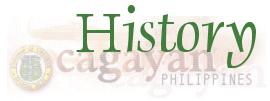
h o m e :: |
Shaking Off the Yoke
The coming together of Spaniards and Cagayan natives in 1581 was not like a shotgun marriage which would eventually end in a separation. There is a document which shows that, in an election presided by no less than Bishop Benavides, the chieftains of Cagayan accepted to live under the protection and tutelage of Spain. Without questioning whether such an election actually took place, one wonders how free were the local chiefs under Spanish muskets which they compared to "clubs that vomited fire." At any rate, what stands undeniable is that the people had again and again, through armed revolts and flight to the hills, sought to end the uneasy relationship with the white men. Although their early attempts at this ended in failure after failure, their day of redemption finally dawned at the turn of the century. Already before the coming of the men of Aguinaldo, Spanish authorities kept watch on the activities of such men as Esteban and Alfonso Donesa, Andres Danguilan, Lucas Battung, Bartolome Talamayan, Esteban Alameda, Manuel Faire, Placido Maguigad and a Doctor Fernando Ricerra from Tuguegarao. Upon the arrival of Daniel Tirona as the head of the revolutionary force from Manila, many native sons immediately sought enlistment in the new army, first and foremost of whom were Don Ricardo Tuyuan, Don Emilio Gannaban and Don tomas Dichoso. The take-over of the province by the revolution was practically bloodless, and only the Spanish prisoners taken in Ilocos towns may have suffered some form of insult and injury. To consolidate the gains of the new republic, Aguinaldo ordered the organization of an adequate army, naming the Brigade for Cagayan and Isabela after Daniel Tirona whom he promoted to the rank of general. In its roster of officers we read such Cagayan names as Romillo, Macanaya, Alvarado, de Rivera, Villaflor, Fonacier and Guibani, and such Isabela names as Paguirigan, Claravall and Padilla. It honors Cagayan and its sister province Isabela that when the time had come for them to run their own affairs, both were ready with sons able and willing for the new responsibilities. But more than in their soldier-sons, the two provinces found greater pride in their civilian-sons who took over the administration of the affairs of state. Under the Aguinaldo Republic, Don Vicente Nepumuceno became Governor of Cagayan, and Don Dimas Guzman became governor of Isabela. Both continued in the chief magistracy of his respective province even after the American forces had prevailed over the revolution, up until the American Military Governbment had been replaced by the civilisan administration of Howard Taft. Assisting Nepumuceno in Cagayan were Don Antonio Carag, Don Esteban Quinto, Don Pablo Guzman and Don Pedro Cuntapay. Cagayan was represented in the Malolos Congress by Don Vicente Guzman. Another Guzman, a Don Antonio, would in later years serve as Delegate of the province to the Constitutional Convention in 1935, and as Commonwealth Assemblyman. Don Gabriel Lasam sat in the First Congress created under the Jones Law, and Don Honorio Lasam, a classmate of Dr. Jose Rizal, would also serve as Provincial Governor. He was the founder of the weekly "La Verdad," a pioneer community paper in Cagayan. Throughout the American regime up to Independence Day, Cagayan has never been found wanting in leadership among her sons. Such names as Carag, Lasam, Macanaya, Sebastian, Arranz, Enrile, Formoso, Casibang, Sabbun and others, figured prominently in the roll of national and provincial leadership. From the resistance movement against the Japanese, Adduru and Balao would emerge as authentic heroes. They were the first Cagayanos to serve in the Cabinet, and while the former had served as Governor and Congressman, the latter would also becomne senator and Commissioner of Reparations. Many Cagayano names are not mentioned here but are assured of a niche in the grateful hearts of their provincemates. When the Japanese ruled the country from 1942 to 1945, whatever blow of insult and injury may have been meant or intended for the Cagayanos has been cushioned by the intervention of such men as Emmanuel, Cepeda, Balao, Tumaliuan, Casibang and others, in the eastern side of Cagayan. ecilio Peņaflor, assisted by his junior officers Pagalilauan, Daza, Balleva, etc. led guerillas in fierce forays behind enemy lines. Right after liberation cagayan was already on its way toward reconstruction led by Don Baldomero Perez, and Don Peregrino Quinto and later by Don Nicasio Arranz, while in Manila, Adduru, Singson, Alonzo, later on joined by Siazon, helped in the rebuilding of the nation.
from Vignettes About Cagayan and the Cagayanos by Msgr. Domingo Mallo-Peņaflor
guestbook :: forum :: contact :: site map :: site info |
|||||||||||||||||||||||||||||||||||||||||||||||||||||||||||||||||||||||||||||||||||||||||||||||



